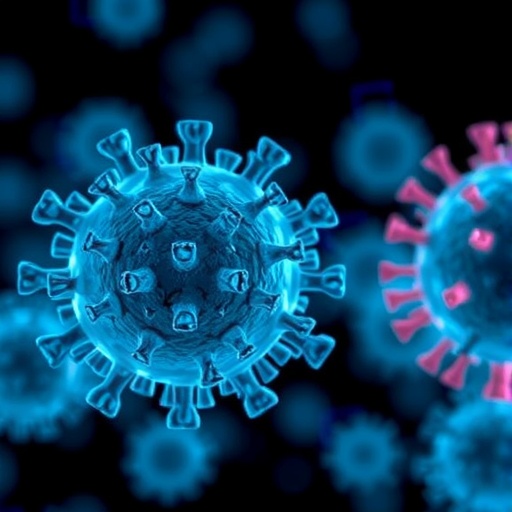Recent research conducted at the University of North Carolina at Charlotte has unveiled startling findings regarding the evolution of the H5N1 virus. Through innovative artificial intelligence methodologies and intricate physics-based modeling, the investigators meticulously examined thousands of viral proteins. The revelations indicate a worrying trend: the virus has developed new strategies that enable it to evade the defensive mechanisms produced by the human immune system. This adaptation not only compromises existing vaccines but raises serious concerns regarding the future trajectory of the virus.
The study draws upon data from over 1,800 H5N1 proteins, where the researchers utilized AlphaFold 3, an advanced artificial intelligence protein folding system, to predict the three-dimensional structures of these proteins. This computational approach allowed the scientists to understand how well these viral proteins interact with antibodies generated by the immune system. As they explored the binding affinity between these antibodies and the viral proteins, the researchers unearthed a troubling trend—over the years, this binding has significantly weakened.
.adsslot_lHhbs10m6o{ width:728px !important; height:90px !important; }
@media (max-width:1199px) { .adsslot_lHhbs10m6o{ width:468px !important; height:60px !important; } }
@media (max-width:767px) { .adsslot_lHhbs10m6o{ width:320px !important; height:50px !important; } }
ADVERTISEMENT
Colby T. Ford, the lead researcher of the study and a computational biologist, expressed his concerns regarding the trajectory of H5N1, stating, “The virus has mutated away from the version we observed a decade ago.” He indicated that these changes have led to a distinct appearance at the molecular level, further illustrating the virus’s capacity for rapid evolution. These alterations have critical ramifications concerning how effective previously developed vaccines may be against current strains of H5N1.
Furthermore, the research team has been employing extensive datasets centered on H5N1 to delineate the various clades of the virus and their specific transmission dynamics. Understanding these pathways is crucial for mitigating the risks associated with potential outbreaks. For instance, the researchers recently implicated a particular clade in the H5N1-related death of an individual in Louisiana, highlighting the direct transmission link between birds and humans, without an intermediary host.
The ongoing analysis has substantial implications for public health and epidemiological strategies. The evolution of the H5N1 virus exemplifies the dynamic nature of pathogens and emphasizes the need to stay ahead of their adaptations. This necessitates a continual reevaluation of existing vaccines, which may no longer provide adequate protection against emerging strains due to their evolving characteristics.
Artificial intelligence is proving to be an invaluable asset in this field of study. The capabilities offered by AI and computational modeling are shedding light on the evolution of the H5N1 virus, ultimately aiding researchers in the identification of more effective antibodies and potential therapeutics. The research group has articulated a methodology through which molecular information from new and emerging strains can be utilized to formulate targeted therapies against the virus. Such advancements represent a promising avenue in the race to combat viral threats.
Another crucial aspect of the ongoing investigation is the potential development of novel therapeutics based on the currently circulating strains of H5N1. Ford emphasized the speed at which new treatments could be generated, stating, “The answer is yes, and we can do it fairly quickly with the AI pipeline we’ve built.” This emphasizes the transformative potential of integrating AI into virology and infectious disease research—a development that could dramatically alter the healthcare landscape.
The implications of this research extend beyond mere academic interest; they touch upon vital public health infrastructures globally. The ability to understand, track, and respond to viral mutations is essential for safeguarding populations against infectious diseases. The precarious balance that exists between humans and viruses such as H5N1 underscores the urgency for continued vigilance and innovation in the face of evolving pathogens.
In the grand tapestry of infectious disease research, the work carried out by Ford and his colleagues exemplifies a pivotal shift toward a more dynamic understanding of viral evolution. By harnessing the power of artificial intelligence and sophisticated modeling techniques, researchers are poised to unveil new strategies to combat incoming threats before they can spiral into pandemics.
The research findings were disseminated at the annual meeting of the American Society for Microbiology, a platform dedicated to advancing microbial sciences and offering critical insights into ongoing research efforts in the field. As scientists gather to share knowledge and strategies at such forums, the collective efforts may result in meaningful action towards mitigating the impacts of H5N1 and other infectious diseases on global health.
Understanding the complexities of H5N1’s evolution and its implications for human health is paramount to ensuring preparedness against future threats. As research in this arena continues to evolve and expand, one thing is clear: the time to act is now, with concerted efforts necessary to develop vaccines and therapeutics aligned with the virus’s adaptive mechanisms.
The ongoing investigation into H5N1 serves as a reminder that vigilance is essential in the era of emerging infectious diseases. With the advanced tools at researchers’ disposal, there remains hope for significant breakthroughs that can transform our response to these evolving threats and protect public health in an increasingly interconnected world.
As we deepen our understanding of H5N1 and its implications, it is crucial to foster collaboration across scientific disciplines to leverage diverse approaches toward tackling this complex issue. The convergence of artificial intelligence, biological research, and computational modeling offers an unprecedented opportunity to design more effective public health strategies, optimize vaccine development, and ultimately safeguard human health.
Subject of Research: Evolution of H5N1 Avian Influenza Virus
Article Title: Evolving Threats: Understanding the H5N1 Avian Influenza Virus
News Publication Date: [Insert Date]
Web References: [Insert URLs]
References: [Insert References]
Image Credits: [Insert Credits]
Keywords
Tags: AlphaFold 3 protein modelingartificial intelligence in virologyevolution of influenza virusesglobal health threatsH5N1 avian influenza virushuman infections from H5N1immune evasion capabilitiesPandemic Preparednesspublic health implicationsuniversity research on virusesvaccine efficacy concernsviral protein analysis





